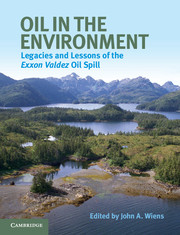Book contents
- Frontmatter
- Contents
- List of contributors
- Use of acronyms
- Acknowledgments
- A bibliographic note
- Prologue
- Part I Introduction and background
- Part II Oil in the environment
- Part III Biological effects
- 9 Cytochrome P450 1A (CYP1A) as a biomarker in oil spill assessments
- 10 Assessing effects and recovery from environmental accidents
- 11 Shoreline biota
- 12 Oiling effects on pink salmon
- 13 Pacific herring
- 14 Oil and marine birds in a variable environment
- 15 Sea otters: trying to see the forest for the trees since the Exxon Valdez
- Part IV Assessing oil spill effects and ecological recovery
- Part V Conclusions
- Index
- References
9 - Cytochrome P450 1A (CYP1A) as a biomarker in oil spill assessments
Published online by Cambridge University Press: 05 July 2013
- Frontmatter
- Contents
- List of contributors
- Use of acronyms
- Acknowledgments
- A bibliographic note
- Prologue
- Part I Introduction and background
- Part II Oil in the environment
- Part III Biological effects
- 9 Cytochrome P450 1A (CYP1A) as a biomarker in oil spill assessments
- 10 Assessing effects and recovery from environmental accidents
- 11 Shoreline biota
- 12 Oiling effects on pink salmon
- 13 Pacific herring
- 14 Oil and marine birds in a variable environment
- 15 Sea otters: trying to see the forest for the trees since the Exxon Valdez
- Part IV Assessing oil spill effects and ecological recovery
- Part V Conclusions
- Index
- References
Summary
Introduction
More than 30 years ago, scientists began measuring biochemical and molecular responses in organisms as a way to understand pathways of exposure to chemicals in the environment. These responses, termed biomarkers, help screen for the presence or absence of classes of chemicals (e.g., aromatic hydrocarbons, metals) and other stressors (e.g., temperature, oxidative stress). They can also indicate possible mechanisms or pathways of potential toxic outcomes and provide direction for additional, more detailed analysis of the effects of exposures.
Biomarkers have been used extensively in studies of oil spills (Anderson and Lee, 2006). Investigations following the Exxon Valdez spill considered biomarkers for many species, including sea otters (Enhydra lutris), river otters (Lontra canadensis), harlequin ducks (Histrionicus histrionicus), Barrow’s goldeneye (Bucephala islandica), black oystercatchers (Haematopus bachmani), pigeon guillemots (Cepphus columba), intertidal fish, rockfish (Sebastes spp.), bottom fish, pink salmon embryos (Oncorhynchus gorbuscha), and mussels (Mytilus spp.).
No biomarker has received more attention than the Cytochrome P450 1A (CYP1A) enzyme system. Tens of thousands of papers have been published on using the CYP1A system as evidence of exposure to aromatic hydrocarbons found in fossil fuels and industrial chemicals. However, there are conflicting opinions in the literature on using the CYP1A system as a measure of low-level oil exposure when multiple sources of aromatic hydrocarbons are present. There are also conflicting opinions on whether the CYP1A system can be used as an indicator of both exposure and of effect or injury.
- Type
- Chapter
- Information
- Oil in the EnvironmentLegacies and Lessons of the Exxon Valdez Oil Spill, pp. 201 - 219Publisher: Cambridge University PressPrint publication year: 2013
References
- 3
- Cited by



